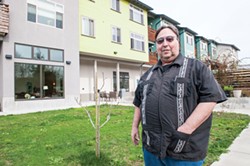Homing the Houseless
Housing First is spreading across the nation, but can it work in Humboldt?
By Thadeus Greenson [email protected] @ThadeusGreenson[
{
"name": "Top Stories Video Pair",
"insertPoint": "7",
"component": "17087298",
"parentWrapperClass": "fdn-ads-inline-content-block",
"requiredCountToDisplay": "1"
}
]
At 52, Brad Saxenhaus had been chronically homeless his entire adult life. A mentally ill drug addict and alcoholic, he'd been in and out of programs, treatment and transitional housing, but always wound up back on the streets, sleeping on the cold ground. "I always said, 'I gotta fix this, I gotta fix this.' I never did," Saxenhaus recalls. "Emotionally and mentally, I was a rotten person."
Then something unexpected happened: A nonprofit called Arcata House gave him the keys to his own apartment, furnished it and helped him move in. "I got into an apartment, but that doesn't make you stable," he recalls. "I would cry. I felt weird living in a house, I really did. It wasn't easy. I had a bed to sleep in, but I still slept on the floor a lot. I don't know why. I was lonely. Out there, I never had a problem with that — there were always people around — but in the apartment, I was lonely."
Most days, Saxenhaus says, he would wake up at his small apartment on Alliance Road in Arcata and catch the first bus heading south. He would arrive at St. Vincent de Paul's free meal facility on Eureka's Third Street before local philanthropist Betty Chinn showed up to dole out morning coffee and doughnuts. He'd sip his coffee sitting on a nearby stoop and just watch the day go by. Then, as the sun set and the air grew cold, he'd catch the bus home.
After a time, the case managers at Arcata House began to prod. "They said, 'You have to go to medical appointments. We'll take you, but you have to go,'" Saxenhaus says, smiling. That was a decade ago. Saxenhaus concedes it took him three or so years to feel normal living off the streets, but he says the folks from Arcata House were always there. They took him to substance abuse classes and doctor appointments, to the grocery store and counseling sessions. When unruly neighbors left him feeling like the walls were closing in and old habits came knocking, Arcata House found him a new place. When he grew despondent, an Arcata House case manager showed up at his door to check in.
"These people are like angels — a bunch of little angels running around and always there to help you," says Saxenhaus, now 62, sitting in his clean, second-story apartment overlooking downtown Arcata.
Many locals are hoping to hear a lot more stories like this in the coming years, as Eureka and the county of Humboldt begin to formally embrace the philosophy of Housing First. The road forward is uncertain and will be fraught with challenges and hurdles, but Saxenhaus' story — and thousands like it around the country — offer hope.
Decades before it began sweeping the nation or even gained a foothold in Arcata, Housing First emerged in New York City, the brainchild of a frustrated psychologist. Born in Greece and raised in Montreal, Sam Tsemberis was treating homeless patients at an inpatient mental health clinic in New York City's Bellevue Hospital. He'd see people treated and stabilized, only to run into them on the streets days later. "It was quite disturbing," he said in a recent phone interview with the Journal.
By the mid/late '80s, Tsemberis switched to outreach, with the goal of getting and keeping people off the streets. This meant getting them "housing ready" — mentally stable and sober — and then finding them a place to live. It was difficult to find success. He'd work to get someone into an alcohol treatment program, only to later find them drunk and back on the same streets. He'd get people mental health treatment and find them homeless and in crisis a month later. "That system was clearly not working," he says, explaining that it's extremely hard for someone who's homeless to manage their mental health, stay sober or become "housing ready." After all, he says, simply surviving while homeless is a labor intensive, exhausting and complicated endeavor.
Frustrated and grasping at straws, Tsemberis and a few colleagues took a radical step: They listened to what their homeless clients wanted and tried to deliver it. Time and time again, people told Tsemberis that they just wanted a safe, warm place to live, so he and his colleagues started there. They secured a grant and set about finding 50 people to put into apartments. But the group wanted the test to be true — they didn't want to cherry pick "housing ready" folks, they wanted to find a model that could endure. So they searched out the most challenging cases — those with dual diagnoses of mental illness and substance abuse who had been chronically homeless, meaning they'd been homeless for more than a year or had at least four episodes of homelessness in a three-year period.
The pilot project found them apartments, furnished them and helped them move in, in some cases even carrying people's shopping carts into their apartments with them. There were no requirements, no mandated counseling or substance abuse treatments, no pledges to be clean and sober. The results were staggering: After the first year, 84 percent of the clients were still housed in their apartments. "That was kind of a huge wakeup call," Tsemberis says. "It was like, 'Hey, we're on to something here because nobody's getting an 84-percent outcome on this population with anything."
Tsemberis says he and his colleagues also realized just how much work it took to keep these people housed during that first year. "The people you are bringing into housing, there's a great relief and a significant improvement, but they are still struggling with addiction, dire poverty, mental health and other health problems," he says. "The housing is a great first step that really just gives you a shot at actually taking care of people. Then the actual work begins. ... It's housing first, but certainly not housing only."
That meant intense case management. Going in, Tsemberis says he and his colleagues knew case managers would be an integral component, but they quickly realized they also needed psychologists and psychiatrists and harm-reduction specialists. The key, Tsemberis says, was letting the clients dictate their treatment. "When you go to most treatment providers, they'll talk to you for a few moments and then they'll tell you what you need to do, 'Take two of these,'" he says. "This is not that. This is not a medical model. This is collaboration. From a relationship dynamic, it engages the person in a very active way to be participating in the plan. They own the plan. It's not like you're imposing a plan on them, they are co-authoring the plan with you."
This resonates with Saxenhaus. "You can bring a bunch of people in off the street, but you really need to change the life of a person," he says. For him, he says this meant constant encouragement and help getting to appointments. He was already sobering up by the time he entered Arcata House's Apartments First, but he needed ongoing counseling, support, and personalized care. When he underwent overnight sleep apnea treatments, someone from Arcata House was there every day to pick him up at 6 a.m. Without much of a support system — estranged from his family and away from his friends on the streets — Saxenhaus says he came to cherish and depend on his care providers. "They're there," he says. "You call them and they call you back. Always."
While continuing to work with its initial clients, Tsemberis' group, Pathways to Housing, looked to expand and replicate its success in the mid- to-late 1990s. The program expanded into each of New York's five boroughs, and the success rates held. With the help of a National Institute of Health grant, they then held a randomized, controlled trial that got published. People began to take notice, though many remained skeptical. "The truth is, we thought the earth was flat," Richard Bebout, a prominent Washington D.C. scholar of homelessness told the Washington Post. "But here (Tsemberis) was saying the earth is round, and we said, 'You've got to be kidding me."
Skepticism about Housing First seems to be rapidly diminishing. In most cases, the numbers speak for themselves: New Orleans reports having ended chronic homelessness among military veterans, while rates of chronic homelessness among veterans nationally has dropped 36 percent in three years under a Housing First approach; Small towns around Brattleboro, Vermont reported a 55-percent reduction in chronic homelessness in just two years; Buffalo, New York, one of the nation's poorest cities, has reduced chronic homelessness by 95 percent in four years; and, in the most jaw-dropping case, the state of Utah has reduced its chronic homeless population by 91 percent in 10 years, from nearly 2,000 people in 2005 to fewer than 200 at the end of 2015.
Just as notable in many circles are the financial impacts. A pilot study by Denver's Colorado Coalition for the Homeless followed 200 chronically homeless people in a Housing First program and found the cost of providing them with emergency services — detox services, incarcerations, emergency psychiatric hospitalizations, inpatient medical care and emergency room visits — dropped 73 percent over two years, saving an average of $31,545 per participant. The study also found that 77 percent of those who entered the program remained housed after the two-year study period.
A similar study of 95 Housing First clients in Seattle reported a cost savings of 53 percent — nearly $2,500 per month, per person. Another study by the Massachusetts statewide Housing First program found it saved an estimated $9,500 per client, per year when comparing Medicaid, shelter and incarceration costs before and after Housing First.
Former U.S. Department of Housing and Urban Development Secretary Shaun Donovan estimated that the average unsheltered homeless person on the streets costs taxpayers about $40,000 a year once all the costs, from shelters and food programs to emergency room and jail visits, are factored in. According to the latest Point-in-Time Count, Humboldt County has about 840 homeless people living unsheltered within its borders. That pencils out to about $33 million annually.
Late last month, the Humboldt County Board of Supervisors and the city of Eureka convened a joint meeting — the first in recent memory — to receive a report from Focus Strategies, a consultant the two governments paid $80,000 to chart a plan to address the county's homeless problem. And, for anyone who doesn't get out much, it is a problem, especially in Eureka.
Nationwide, the average community reports that about 1 percent of its population is homeless. That number holds true in Humboldt County, which has about 135,000 residents and a homeless population of about 1,320, according to data from the PIT count and the U.S. Census. But Eureka — the county seat where the vast majority of social services are located — obliterates those numbers with one of the highest homeless rates in the country, about 2.7 percent of its population.
But those numbers don't convey the depth of Humboldt's homeless issues. Nationwide, 70 percent of the homeless population is classified as "sheltered," spending nights under a roof, whether in a shelter, a friend's house or a motel. In both Humboldt County and Eureka, those numbers are essentially flipped, with 64 percent of the homeless population unsheltered. Perhaps more ominous is that while just 15 percent of the national homeless population is classified as "chronic," 69 percent of Humboldt's homeless people have reported being houseless for a year or more, with many, like Saxenhaus once was, on the streets for a decade or more.
In the "Homeless Strategy and Implementation Plan — Phase 1" reported to the supes and the council at the Jan. 26 joint meeting, Focus Strategies recommends a dual approach to tackling the problem locally.
First, to address the non-chronic homeless, the consultant suggests a Rapid Rehousing model, one that essentially takes able-mind-and-bodied homeless people and helps them get back on their feet through housing searches, short-term financial assistance, budgeting education, child care and links to community-based programs. The idea is that these folks, with a small hand up — a security deposit here or some job training there — can be reintegrated back into society quickly.
Addressing the chronically homeless is more complicated, and begins with the premise that many — due to severe mental illness and other factors — will simply never be able to enter the working class. Under the Housing First model, the goal is simply to give them a safe place to live and to try to bring them as many "wraparound" services — case management, substance abuse counseling, mental health treatment, etc. — as possible to make them as independent and healthy as possible.
The catch with permanent supportive housing is that, while it's proven to be far more cost-effective than letting people languish on the streets, the expenditures don't align. For example, a homeless person who is repeatedly admitted to the emergency room due to alcoholism receives uncompensated care from the hospital, costs that the hospital eats and spreads around to the rest of its bill-paying customers. Housing First has proven to reduce those costs, but that doesn't mean hospitals are passing those savings back to local governments. Similarly, Housing First has proven to reduce law enforcement contacts and incarcerations, which saves local governments money. But it's not like local governments can or will cut police and jail budgets in order to fund a Housing First approach.
With Housing First, governments are looking at up-front costs to realize long-term savings spread through a variety of public and private systems. That can be a hard sell.
As outlined by Focus Strategies and practiced elsewhere, Housing First's permanent supportive housing clients generally are eligible for public assistance, often in the form of supplemental security income, and are asked to pay 30 percent of their income toward rent. The balance — as well as things like deposits, first and last months' rent — is paid through rent assistance, sometimes using a designated funding stream like the Mental Health Services Act and other times through another source, like a grant, a local government or a housing trust fund.
But however you fund Housing First, Tsemberis says it absolutely has to be sustainable. You can't take someone in only to turn them out when the money runs out, and you can't take someone in and then fail to fund or deliver the services they need.
"You can't find people who have all these needs and put them into housing without the wraparound services to care for them. It's a recipe for disaster," Tsemberis says. "Someone has to figure out how to get the money."
Housing First's single greatest success story, the state of Utah, is perfect alignment of factors. Utah's a prosperous state with some of the lowest poverty and unemployment rates in the country. Its state government regularly finishes the year with a budget surplus. Both the governor and the mayor of the state's largest city were outspoken supporters of Housing First, as was the state's largest non-government organization — the Church of Jesus Christ of Latter Day Saints — which is also an unrivaled fundraising and volunteer-organizing powerhouse.
"They committed to doing Housing First big time," says Tsemberis. "If we had failed [in Utah], there was really no hope."
Utah had money to throw at Housing First — state funds to capture matching grants, private sector money to invest and charitable donations to contribute — that allowed it to quickly build hundreds of new housing units with a virtual army of volunteers waiting to furnish them and stock their pantries. But Tsemberis and others intimately involved in the effort say just as important was that the state unified behind the philosophy. This makes sense, given the Mormon Church's belief in charitable work. After all, the church has its own welfare department to take care of members down on their luck.
At a recent speaking engagement in Redding, Lloyd Pendelton, who left his post as the executive manager of the LDS Church Welfare Department to head the state's homeless task force and oversee the implementation of Housing First, said the key to a successful rollout is having a community champion, someone who can bring diverse stakeholders behind a common goal. That and getting to work. He urged people not to wait for an implementation plan and to see things through a positive light. "It shouldn't be, 'We want to end homelessness.'" he told about 500 people gathered in a middle school auditorium. "It should be, 'We want to put people in housing.'"
To some extent, that's the approach Focus Strategies is taking in Humboldt, too, urging the Eureka City Council and the supes to pledge to house 30 people in 60 days. (Neither has made the commitment yet.)
In its 51-page report, Focus Strategies argues there is enough existing housing stock in Humboldt County to immediately make a significant dent in the unsheltered homeless population. Specifically, the consultant estimates there are 259 available units in the county, enough to house the current unsheltered population in a single year if clients were to share rooms, though the consultant concedes that this approach might be difficult "given the complexity of the mental health and substance use issues in the unsheltered population." A three-year approach, Focus Strategies claims, could get everyone housed without doubling up in rooms.The report, however, doesn't include any survey of landlords to see how many of the properties fall into the low-income category, or how many property owners would be willing to offer up units to the formerly homeless who may be mentally ill and addicted.
And though it outlines a number of options, the Focus Strategies report doesn't recommend a specific funding stream to implement Housing First in Humboldt. Judging from public comment at recent council meetings, the popular sentiment in Eureka seems to be that the county — and specifically its Department of Health and Human Services — has the resources to put this plan into motion. That's not exactly the case. The county budget has a multimillion dollar structural deficit that is projected to balloon in coming years. Even today, only the influx of Measure Z funds has stabilized the county's spending plan. The temporary tax measure is slated to expire in a few years. As far as DHHS goes, the department has a large budget but it's almost entirely tied to funding streams and services. While it can direct services toward eligible Housing First clients, there's no indication it has millions of dollars squirreled away somewhere to throw at the cause.
Meanwhile, Eureka has some funding from its former redevelopment agency — $250,000 — that it's already voted to repurpose toward the plan. And while the city, like the county, is in a financial pinch — it carved some $4 million from this year's budget to make ends meet — tough choices may be necessary. After all, the city is combining to spend more than $1.5 million this year on the zoo, the chamber of commerce and the Humboldt County Convention and Visitor's Bureau.
There are also some funding options that could leave the city and county general funds intact. Last year, the grand jury recommended the formation of a housing trust fund, which has been successful in other areas. Essentially, these create an independently managed pool of money with an identified funding stream, like developer fees or a new tax, to be used for local housing aid and projects.
In short, Focus Strategies' plan leaves some large questions about how a Housing First strategy can be funded and implemented on a countywide level. But those who have seen Housing First up close say there are always scores of daunting reasons not to do it but there is one very compelling reason to figure it out: It works.
It was a sunny September day when, under a cloudless blue sky, a host of local officials and notables gathered to unveil Arcata Bay Crossing, a $5.7 million, 30-unit housing development. Many of the new residents were moved in directly off the streets. Others came after brief stays at the Multiple Assistance Center in Eureka. A couple others came from Sempervirens, the county mental hospital.
"In Arcata, we end homelessness by building housing," Fox Olson, then the executive director of Arcata House Partnership, told the crowd. "I want the rest of the county to take note."
While the statement seemed to ignore the fact that the facility was built in cooperation with DHHS, or that the agency brought almost $2 million in one-time Mental Health Services Act funds to the table to make it possible, Olson's point was clear: Arcata's been successfully using a scaled Housing First model for some time.
Six months after that day, on a cold and rainy February afternoon, Jerry — who requested his real name not be used in exchange for his full candor — sat in the small smoking area of Arcata Bay Crossing's courtyard. The place still looked brand new and immaculately kept.
He's obviously nervous and having trouble finding the words. He repeats several times that he had lived in his van for a year and a half, but asked where or why, he struggles and repeats himself, taking long pauses. Finally, talking about his tie-dye shirt, he smiles and the words come a bit easier. Jerry explains that he's an alcoholic, that he spent 18 months living out of his van in Eureka and then another year and a half staying in a dingy Eureka motel before moving into Arcata Bay Crossing. "You know, it was really bad," he says. "And then I came here."
Jerry describes himself as "higher functioning" than some of the other people there. He says he has a couple of neighbors he's friendly with, but says he mostly keeps to himself. He still drinks, he says, but not as much as he used to. He's feeling healthier, he says, and definitely safer. He passes his days reading mystery novels and listening to KGOE, a talk radio station, even though he doesn't have much interest in politics. He says he's working with his case manager to get a dog to keep him company, but says life at Arcata Bay Crossing is good. "I'm so thrilled," he says. "I just can't tell you how happy I am."
Officials say all the residents who moved into Arcata Bay Crossing's 30 units remain housed six months later, save for one woman who was sent to prison for an offense committed prior to her September move-in. "These are the neediest of the needy, and they're all still housed, which is really big," explained Darlene Spoor, who recently took over from Olson as executive Director of Arcata House (the nonprofit has an event scheduled to officially welcome Spoor the afternoon of March 15). "If somebody is chronically homeless and they're still housed after six months, that's really big."
Spoor explains that Arcata House relies on a hodgepodge of grants and private donations to operate its transitional housing program, which includes five houses throughout the city that accommodate up to six people apiece, and Apartments First, which features 19 units sprinkled around town. She said there are three keys to the nonprofit's success with Housing First: a supportive community, willing landlords and intensive case management.
"Our landlords — without their support, we couldn't do what we do," Spoor says, explaining that Arcata House signs leases for its tenants, who then sublet from the nonprofit. This means Arcata House is the one that pays the rent and is liable for any damages, which puts landlords at ease, Spoor says. And, when a landlord calls with a problem, Arcata House always responds immediately, she says.
The importance of proactive case management also cannot be understated, Spoor says. "The plans are individualized, but the case management is intensive," she says. "Our staff is on call 24/7, and we're there and we mediate and negotiate and train."
As Arcata and Utah can attest — albeit on very different scales — Housing First is truly a community endeavor. As Tsemberis sees it, it's the delivery of a basic human right — housing — to our most vulnerable residents. But the numbers show it's also sound fiscal policy.
Several decades ago on the streets of New York, Tsemberis said he learned the key to addressing homelessness is personalization — treating each client as an individual and finding the right path to get them housed, one person at a time. "It's a movement," he says, "and every movement has a leader, but you also need to have a tremendous amount of support from the troops and the entire community. You have to get everyone involved."
The stakes are high. Sitting in an easy chair in his apartment, Saxenhaus explains that, born in New York, he grew up in Florida and became suicidal as a teenager. He left home, started wandering and self-medicating with drugs and alcohol. Chance brought him to Humboldt. He pauses for a moment, eyes Heavenly, his large, long-haired cat, and says he'd likely be dead or dying if it weren't for the keys Arcata House gave him almost a decade ago.
"This program changed me," he says, adding that he's now independent, standing firmly on his own feet with little support from Arcata House. "I give it all to God and Arcata House. God first, and Arcata House second."
Comments (4)
Showing 1-4 of 4
more from the author
-
Seeking Salvation
'Living in amends,' a candidate for resentencing hopes for another chance
- Apr 18, 2024
-
UPDATE: Artillery Shell Deemed Safe in Ferndale
- Apr 12, 2024
-
Turning the Titanic
Cal Poly Humboldt recognized for leadership in addressing global plastics crisis
- Apr 11, 2024
- More »
Latest in News
Readers also liked…
-
Through Mark Larson's Lens
A local photographer's favorite images of 2022 in Humboldt
- Jan 5, 2023
-
'To Celebrate Our Sovereignty'
Yurok Tribe to host gathering honoring 'ultimate river warrior' on the anniversary of the U.S. Supreme Court ruling that changed everything
- Jun 8, 2023







































